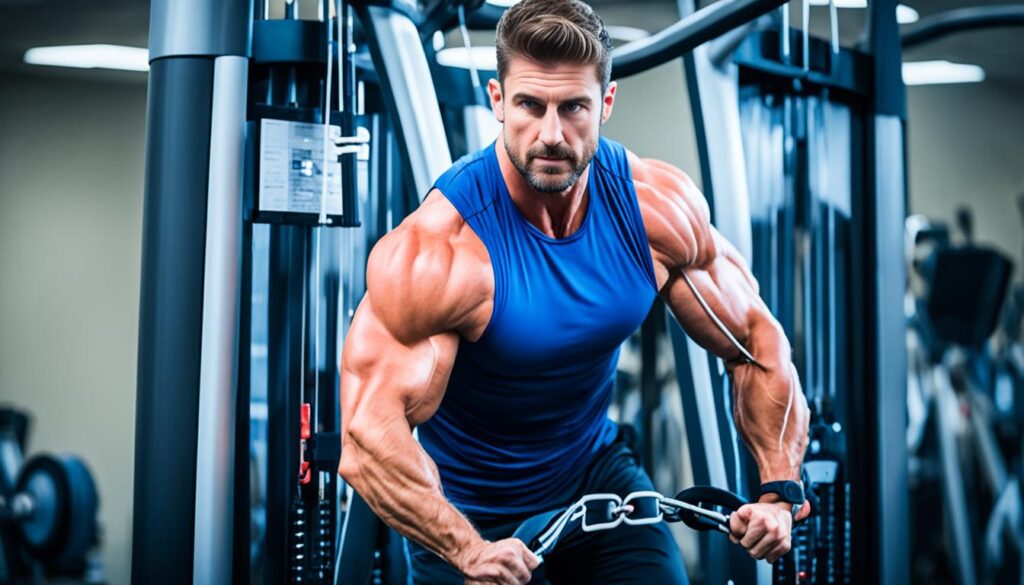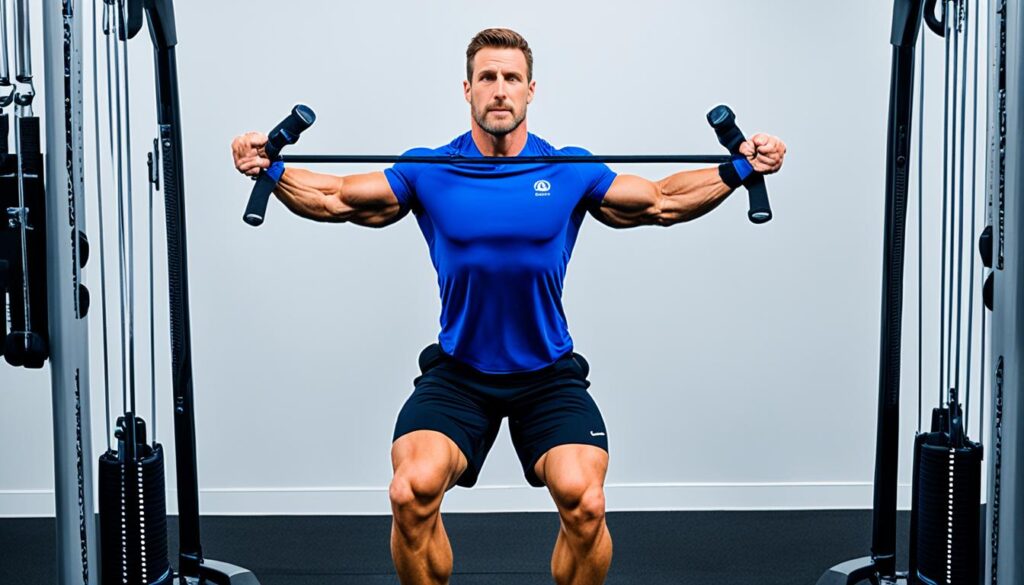As a fitness enthusiast, I understand the importance of maintaining a strong and stable lower back. Dealing with persistent lower back pain can be a frustrating and debilitating experience, impacting our daily activities and overall quality of life. However, incorporating cable-based exercises into your workout routine can be a game-changer in strengthening your core and alleviating lower back discomfort.
Key Takeaways
- Cable exercises target and strengthen the core muscles, including the lower back, to improve stability and posture.
- Proper form and technique are crucial when performing cable workouts to avoid injury and maximize the benefits.
- Incorporating cable exercises into a well-rounded fitness routine can help alleviate lower back pain and improve overall physical function.
- Cable-based workouts can be easily integrated into your gym routine using readily available equipment.
- Consistent cable training can lead to improved muscle strength, power, and endurance in the lower back and core region.
In this article, I’ll guide you through an effective cable workout routine specifically designed to target and strengthen your lower back, while also engaging your core muscles. You’ll learn about the key benefits of cable exercises, the proper form and technique to ensure safe and effective workouts, and how to seamlessly incorporate these exercises into a comprehensive fitness regimen.
The Importance of a Strong Lower Back
Maintaining a robust lower back is crucial for overall physical well-being. The lower back, along with the core muscles, plays a vital role in supporting the spine, ensuring proper posture, and promoting balance and stability throughout the body. Weakness or imbalances in this area can lead to common lower back pain issues, hindering your ability to perform daily tasks and engage in physical activities comfortably.
Understanding the Role of the Core Muscles
The core muscles, which include the abdominals, obliques, and lower back, work together to stabilize the spine and provide a solid foundation for movement. When these muscles are strong and engaged, they help to alleviate pressure on the lower back, reducing the risk of injury and discomfort. Incorporating exercises that target the core, such as those using cable machines, can greatly improve lower back strength and overall spinal health.
Common Lower Back Pain Issues
Weak lower back muscles can contribute to a range of issues, including:
- Chronic lower back pain
- Poor posture and alignment
- Decreased stability and balance
- Limited range of motion and flexibility
- Increased risk of injury during physical activity
By prioritizing lower back and core strength, you can mitigate these problems and enjoy a more comfortable, active lifestyle. The cable exercises featured in the upcoming sections can be a valuable addition to your fitness routine, helping to build a stronger, more resilient lower back.
“A strong lower back is the foundation for a healthy, pain-free body. Investing in its development can unlock a new level of physical and mental well-being.”
Cable Workout For Lower Back
Incorporating cable exercises into your lower back workout regimen can be a game-changer. These versatile tools offer a unique set of benefits that can help you target and strengthen the essential muscles in your core and lower back. By harnessing the constant tension and multi-planar movement capabilities of cable resistance, you can unlock a new level of muscle activation and stability.
Benefits of Cable Exercises
Cable exercises excel at keeping the muscles under constant tension throughout the entire range of motion, which can lead to greater muscle engagement and ultimately, more effective workouts. Unlike free weights, cables allow you to move through a variety of planes, targeting the lower back from different angles and engaging a wider array of stabilizing muscles. This versatility can translate to improved posture, balance, and overall core strength.
Preparing for Your Cable Workout
- Warm up thoroughly to prepare your body for the targeted cable exercises.
- Adjust the cable height and resistance to match your specific needs and fitness level.
- Focus on maintaining proper form and control throughout each movement, rather than using excessive weight.
- Engage your core and maintain a stable, upright posture to maximize the effectiveness of the exercises.
By prioritizing proper setup and technique, you can unlock the full potential of cable-based lower back workouts and experience the benefits of enhanced cable resistance training. Stay tuned for a deep dive into specific cable exercises that can strengthen your lower back and core.

Lower Back Exercises with Cables
Strengthening the lower back is crucial for maintaining overall spinal health and stability. One highly effective exercise for targeting the lower back muscles is the cable row. This compound movement not only builds lower back strength but also engages the muscle activation of the entire posterior chain, including the lats, rhomboids, and trapezius.
Cable Rows for Back Strength
To perform the cable row with proper form, stand facing a cable station with your feet shoulder-width apart. Grip the rope or handle with an overhand grip, keeping your back straight and core engaged. Initiate the movement by driving your elbows back, pulling the weight towards your upper abdomen while squeezing your shoulder blades together. Pause briefly at the top of the movement, then slowly return to the starting position. Focus on maintaining a neutral spine and avoiding excessive arching or rounding of the lower back.
“Proper form is crucial when performing cable rows to maximize the benefits and prevent injury. Engage your core, keep your back straight, and focus on using your back muscles to drive the movement.”
Incorporating cable rows into your fitness routine can significantly improve lower back strength and stability, which is essential for maintaining good posture, reducing the risk of lower back pain, and enhancing overall athletic performance.
| Exercise | Target Muscles | Benefits |
|---|---|---|
| Cable Rows | Latissimus dorsi, trapezius, rhomboids, rear deltoids | Strengthens the lower back, improves posture, enhances overall upper body strength |
Core Strengthening with Cable Pulldowns
When it comes to building a strong and stable core, cable pulldowns are a fantastic exercise to incorporate into your routine. Beyond targeting the lower back, this versatile movement can effectively engage the core muscles, including the abdominals, obliques, and stabilizers.
The key to unlocking the core-strengthening benefits of cable pulldowns lies in maintaining proper form and focusing on core activation throughout the movement. By keeping your abdominal muscles engaged, you can ensure that the tension generated by the exercise is distributed evenly across your midsection, rather than solely relying on the larger muscle groups like the lats.
- Start by setting the cable pulley to a height that allows you to grip the handle with your arms extended overhead.
- Keeping your core braced, initiate the movement by pulling the cable downward, focusing on driving the elbows back and squeezing your shoulder blades together.
- As you pull the cable down, consciously engage your abdominal muscles to maintain a neutral spine and prevent excessive arching in your lower back.
- Slowly return to the starting position, resisting the urge to let the weight of the cable pull your torso forward.
By emphasizing core engagement during cable pulldowns, you’ll not only strengthen your lower back but also improve overall trunk stability and support. This enhanced core strength can have a positive impact on your performance in other exercises, as well as your daily activities.
Incorporating cable pulldowns into your strength training routine is an excellent way to target multiple muscle groups and enhance your overall core strength and stability. Remember to focus on proper form and conscious abdominal activation to maximize the benefits of this versatile exercise.
Incorporating Lat Pulldowns
When it comes to building a strong, sculpted back, lat pulldowns are a must-have exercise in your routine. This cable-driven movement targets the latissimus dorsi, or lats, the large muscle group responsible for pulling the arms down and back. Mastering the proper form and technique for lat pulldowns is crucial to maximize muscle activation and back strength.
Proper Form and Technique
To perform lat pulldowns effectively, start by adjusting the cable height so the bar hangs at about chest level when you’re seated. Grip the bar with an overhand, shoulder-width grip, keeping your torso upright and core engaged throughout the movement. Initiate the pull by driving your elbows down and back, focusing on squeezing your shoulder blades together as you lower the bar towards your upper chest. Avoid swinging or using momentum to move the weight; the movement should be controlled and deliberate.
- Maintain proper posture with your chest up and shoulders back.
- Keep your core braced to stabilize your torso.
- Concentrate on pulling the bar straight down, not towards your chin.
- Slowly return the bar to the starting position with control.
By emphasizing proper form and a strong mind-muscle connection, you’ll ensure that your back muscles are doing the work and reaping the benefits of this effective exercise.
“Proper technique is key for maximizing the muscle-building benefits of lat pulldowns. Focus on keeping your core engaged and squeezing your shoulder blades together at the bottom of the movement.”
Straight-Arm Pulldowns for Posture and Stability
Incorporating straight-arm pulldowns into your workout routine can be a game-changer for improving your posture and overall trunk stability. This unique cable exercise targets specific muscle groups that play a vital role in maintaining proper alignment and reducing the risk of lower back pain.
The straight-arm pulldown engages the lats, deltoids, and triceps, helping to strengthen the upper back and shoulder muscles. By keeping your arms straight throughout the movement, you’ll also activate the core muscles, including the abdominals and lower back, which are essential for maintaining good posture and spine stability.
Proper form is key when performing straight-arm pulldowns. Focus on keeping your shoulders down, chest up, and core engaged. Initiate the movement by driving your elbows back, keeping your arms straight, and pulling the cable bar down towards your thighs. Slowly release the weight back to the starting position, maintaining control throughout the exercise.
| Muscle Engagement | Benefits |
|---|---|
| Lats, Deltoids, Triceps | Strengthens upper back and shoulder muscles |
| Abdominals, Lower Back | Improves core stability and posture |
By incorporating straight-arm pulldowns into your cable workout routine, you’ll not only build a stronger, more defined back but also enhance your overall posture and stability. This exercise is a valuable addition to any well-rounded fitness program, helping to support a healthy and pain-free lower back.

“Straight-arm pulldowns are a fantastic exercise for targeting the lats and improving overall trunk stability. Mastering this movement can have a transformative effect on your posture and lower back health.”
Creating a Well-Rounded Fitness Routine
To get the most out of your cable-based lower back workout, it’s vital to incorporate it into a comprehensive fitness routine. Combining these cable exercises with other workout modalities can help you achieve a balanced and holistic approach to fitness and overall well-being.
Combining Cable Exercises with Other Workouts
While cable exercises are excellent for targeting and strengthening the lower back, they shouldn’t be the sole focus of your fitness regimen. Incorporating a variety of exercises into your routine can help build muscle, improve strength, and prevent injuries.
- Complement your cable workouts with compound strength-training exercises, such as squats, deadlifts, and pull-ups, to engage multiple muscle groups and promote overall muscle building.
- Include cardiovascular exercises, such as brisk walking, cycling, or swimming, to improve your endurance and support long-term fitness.
- Incorporate flexibility and mobility exercises, like yoga or dynamic stretching, to maintain joint health and reduce the risk of injury.
By creating a well-rounded fitness routine that combines cable exercises with other workout modalities, you can maximize the benefits of your Fitness Routine and achieve your Workout Combination and Muscle Building goals while Injury Prevention.
“Variety is the spice of life, and the same holds true for your fitness routine. By incorporating a diverse range of exercises, you can challenge your body, prevent plateaus, and achieve a higher level of overall fitness.”
Conclusion
In my fitness journey, I’ve found that incorporating a cable-based workout into my routine has been a game-changer for strengthening my lower back and core, improving my posture and stability, and alleviating any lower back pain. By following the targeted exercises and practical tips outlined in this article, I’ve been able to achieve my fitness goals and enhance my overall physical well-being.
The versatility of cable machines has allowed me to target the key muscle groups in my lower back and core, leading to increased strength, endurance, and better control over my body movements. From the effective cable rows that have reinforced my back strength to the core-challenging cable pulldowns, I’ve experienced tangible results that have translated to improved performance in my other workout routines and daily activities.
Whether your aim is to build lower back strength, enhance core stability, or simply maintain a healthy and balanced fitness level, I highly recommend exploring the transformative power of cable-based exercises. By incorporating these techniques into your workout regimen, you’ll be well on your way to unlocking your full physical potential and achieving your desired fitness goals.
FAQ
What are the benefits of a cable-based lower back workout?
Cable exercises are highly effective for targeting and strengthening the lower back muscles. They provide constant muscle tension, allow for multi-planar movement, and the ability to isolate specific muscle groups. This can lead to improved lower back strength, core stability, and overall physical well-being.
How do I properly prepare for a cable-based lower back workout?
Before starting your cable workout, it’s important to warm up properly. This can include dynamic stretches, light cardio, and some bodyweight exercises to get your muscles activated and ready for the targeted cable exercises. Proper form and technique are also crucial, so be sure to start with lighter weights and focus on controlled movements.
What are the key cable exercises for strengthening the lower back?
Some of the most effective cable exercises for targeting the lower back include cable rows, lat pulldowns, and straight-arm pulldowns. These exercises engage the major muscle groups in the back and core, helping to improve overall strength, posture, and stability.
How can cable pulldowns help strengthen the core?
In addition to targeting the lower back, cable pulldowns can be an excellent way to strengthen the core muscles. By focusing on engaging the abdominal muscles during the exercise, you can improve overall trunk stability and support, which can have a significant impact on lower back health.
What is the proper form for performing lat pulldowns with cables?
Proper form is crucial for getting the most out of lat pulldowns. Start by grasping the lat pulldown bar with an overhand grip, slightly wider than shoulder-width. Initiate the movement by pulling the bar down towards your chest, keeping your elbows close to your body and avoiding any swinging or momentum. Focus on squeezing your shoulder blades together at the bottom of the movement.
How can straight-arm pulldowns benefit my posture and stability?
Straight-arm pulldowns are a unique cable exercise that can help improve posture and overall trunk stability. By keeping your arms straight and pulling the cable bar down in front of your thighs, you engage the lats and core muscles, which can have a positive impact on your posture and support your lower back.
How can I incorporate cable exercises into a well-rounded fitness routine?
To get the most out of your cable-based lower back workout, it’s important to combine these exercises with other training modalities, such as strength training, cardiovascular exercises, and mobility work. This balanced approach will help you achieve your fitness goals, improve overall physical function, and reduce the risk of injury.






